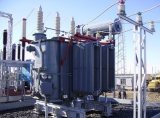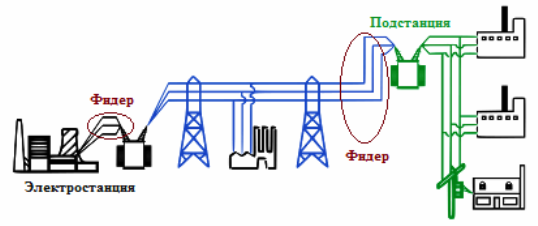What is an electric feeder in electricity
 The word «feeder» (borrowed from the English language: «feeder») is a polysemantic term. In fishing it is one thing, in electrical engineering it is another, in radar it is the third. Among the translations of this word are: feeder, feeder, transmission mechanism, feeder, auxiliary line, etc., depending on the context.
The word «feeder» (borrowed from the English language: «feeder») is a polysemantic term. In fishing it is one thing, in electrical engineering it is another, in radar it is the third. Among the translations of this word are: feeder, feeder, transmission mechanism, feeder, auxiliary line, etc., depending on the context.
Feeder — 1) in the electric power industry — a cable or overhead power line connecting a power plant to a power distribution system; calculated for voltages up to 10 kV. 2) in radio engineering — a line for transmitting the energy of the HF field. Most often, the feeder connects the transmitter to the antenna and the antenna to the receiver.
In order not to get confused, let's take a closer look at what an electrical power supply is, that is, consider this term in relation to the power industry.
Despite the fact that every electrician understands the meaning of this word in principle, there are options even here.This can be a network that supplies transformers to substations and connects transformers to a specific circuit breaker, in terms of 6 to 10 kV mains.
In practice, the power supply is remembered when, for example, on substation the common switch is turned off, thus removing power from all transformers. In this case, it is said that the load on the supply network is removed at the substation. If the cable connecting the breaker to the main transformer is damaged, the feeder is said to be damaged. That is, the feeder here is the line that serves to supply power to the user from the substation feeder cell.
A line (power supply) with a voltage higher than 1000 V may contain high voltage switching devices, reactors, limiters, measuring transformers for voltage and current, insulators, busbars and current conductors, power cables and overhead power lines, capacitor assemblies, as well and relay protection and automation devices. Several feeders form a switchgear (switchgear): open (switchgear), closed (closed switchgear), complete for internal (switchgear) or external (switchgear), stationary (KSO).
In the electric power industry, a power line is called a power line, passing from substation to substation or from substation to switchgear. First of all, it should be understood that the power supply is what is connected to the power supply of the equipment.A feeder is a trunk line that connects an electrical substation to a switchgear.
In network design, a feeder is a cable that supplies power from a switchgear to a consumer or to the next distribution node. Those lines that go further from the distribution block are called branches.

The feeder can be overhead or wired, but one thing is constant: the feeders connect the switchgear busbars of transformer or converting power plants and the distribution or consumer electrical networks fed by those busbars.
For example, in traction power supply, the feeder is part of the traction network that connects the voltage buses from the traction substation to the contact network. The power supplies are equipped with overload and short-circuit protection devices by means of circuit breakers that disconnect the contact network in case of exceeding the protection setting, as well as high voltage disconnectors.
The equipment connected to the feeder is called feeder equipment: feeder automation, feeder disconnector, feeder protection, etc. Depending on the purpose of users to receive energy from the overhead network for a particular feeder, the feeder is called , say, in terms of traction networks, a station or a ferry. Each feeder is assigned an individual number.
By the way, the word "power supply" everywhere can rightfully be replaced with the word "power line", since the power supply is essentially a type of power line.Although the feeder line is peripheral in the network hierarchy, it is still a branch of the network that connects more or less remote nodes to the main feeder unit.
In fact, a feeder is a transmission line connecting a primary distribution device to a secondary distribution device or to several secondary distribution devices, or a secondary distribution device to a consumer or to several consumers.
